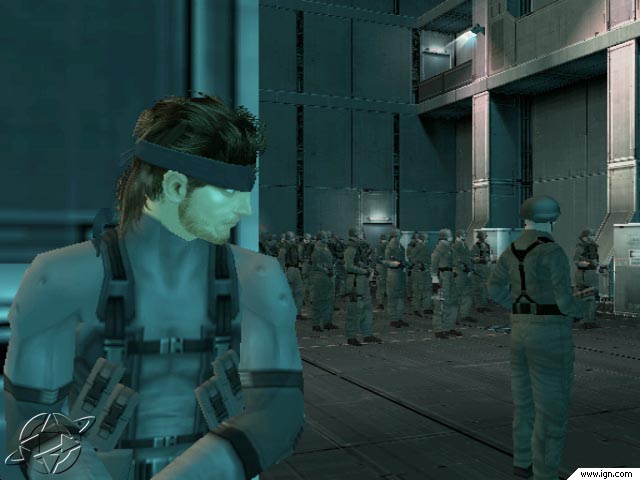Giant Robots Land On Sony
April 17, 2001
The giant robot: a staple of Japanese and American pop culture for decades. From Voltron to Evangelion, Robotech to BattleTech, their incarnations are as varied as their designs. Only one thing stays the same in all cases: giant robots rock.
Konami’s Zone of the Enders is the newest giant-robot game on PlayStation 2, following others such as From Software’s Armored Core 2 and Working Designs’ Gungriffon Blaze. However, while the Armored Core series tends to be toward the more realistic side of the giant-robot genre with its heavy, ponderous walking tanks, Zone of the Enders takes the other road. The machines here fly, are quick and agile, and fight with swords and energy waves more often than artillery and missiles.
The game opens with an armada of Orbital Frames, as the robots are called in this instance, descending upon Antilia, a massive space colony in orbit around Jupiter. The title of the game refers to the station’s inhabitants; Antilia is the colony farthest from earth, and its inhabitants “enders.”
As the invasion begins, a young boy named Leo sees his friends crushed by a shattered frame. Fleeing attack from the invading forces, he stumbles upon a new-model Orbital Frame, Jehuty. He falls into the cockpit, and after meeting the resident artificial intelligence, ADA, he is quickly forced to defend himself from another attacking machine. The rest of the game follows the reluctant Leo’s attempts to save the colony and repel the invading forces.
There is a fair amount of story to the game, but that’s not where the meat is. Fighting is most of what you’ll be doing in this game: fighting over towns and amid skyscrapers; in culverts and maintenance tunnels; even in the zero-gravity hub of Antilia. The player moves from area to area through an overhead map of the colony, collecting new programs for Jehuty and clearing the colony of enemy frames.
The colony and frames are both presented beautifully. The graphics in this game are gorgeous and detailed, fluidly animated, and almost everything you see can be destroyed. Houses, bridges, industrial buildings, enemy frames; if it’s there, you can probably blow it up, and if you don’t, something else might.
The fighting itself is fast and brutal. Most long-range attacks are fairly weak, so the best tactic is often to get up an enemy frame’s face and hack at them with Jehuty’s arm-mounted sword. The enemy is good at hacking back, however, so your machine is also equipped with shields, an energy weapon, and a chargeable energy-ball attack. There are also several ammo-dependent sub-weapons to find, such as a rapid-fire cannon and a homing shot.
The control is intuitive and fluid. There are no complex button combinations, and the game’s camera angles are almost never awkward. The player can move Jehuty up and down to attack or escape enemies at different altitudes, and there is a simple, well-executed lock-on system for battles. Two buttons are used for attacks: one for sword and beam attacks, depending on range, and one for sub-weapons. This simplicity is especially important in the case of boss battles. There are several enormous manned Orbital Frames on-hand to supplement the main, computer-controlled invasion forces.
However, there are a few problems with the game. Firstly, the game is short. The first time through the game should take around five hours, six at maximum. While the game is fun, it has limited replay value, since there is only one main ending. While there is an alternate ending music theme for those who get good scores on the occasional rescue missions, which penalize you for destroyed buildings or lost lives, there are few, if any, other secrets. Several difficulty levels help allay this somewhat, but there is simply not enough depth.
Secondly, aside from the four bosses, there are only three enemy types to fight: a long-range frame, a close-range frame, and a well-balanced frame. While there are plenty of them, and plenty of ways to take them out, it gets repetitive seeing the same faces time and again.
Thirdly, there is the story. It may be just the victim of a bad translation or what, but it makes little sense. The enemy forces’ motives are nebulous and never fully explained; they are after Jehuty and its “twin,” but the player never learns why. The ending is abrupt and acts practically as a “To Be Continued” message, and most characters are never really developed. All we know about Leo is that he’s a whiny twerp; all we know about his rescued friend Celvice is that she’s his friend; and, with one exception, all we really know about any of the enemy personalities is that they’re the enemy. Other supporting characters are equally neglected, and the voice acting is uninspired at best.
Finally, a small gripe. The designs for the various Orbital Frames are generally very good, but for the manned models, the command centers are placed in a large, cone-shaped protrusion situated between the robot’s legs. It’s an odd design choice, and gives new meaning to the term “cockpit.”
Despite its few problems, Zone of the Enders still a worthwhile purchase for those looking for a bit of adrenaline-fueled giant-robot fighting action. There hasn’t been a really good arcade-style action game like this for quite some time, and its’ a welcome change from the complexity of many other titles.
It should also be mentioned that the game comes with a short demo of the highly anticipated Metal Gear Solid 2: Sons of Liberty. This demo is, quite simply, astounding in all respects. Visuals, direction, sound, gameplay; this is truly the next generation. While only about an hour long, it shows exactly what the PS2 is capable of, and is a great forecast of things to come.





























































































































